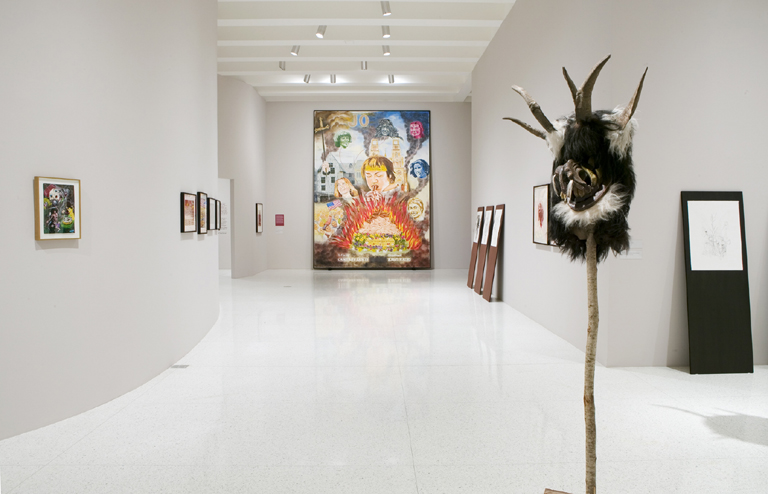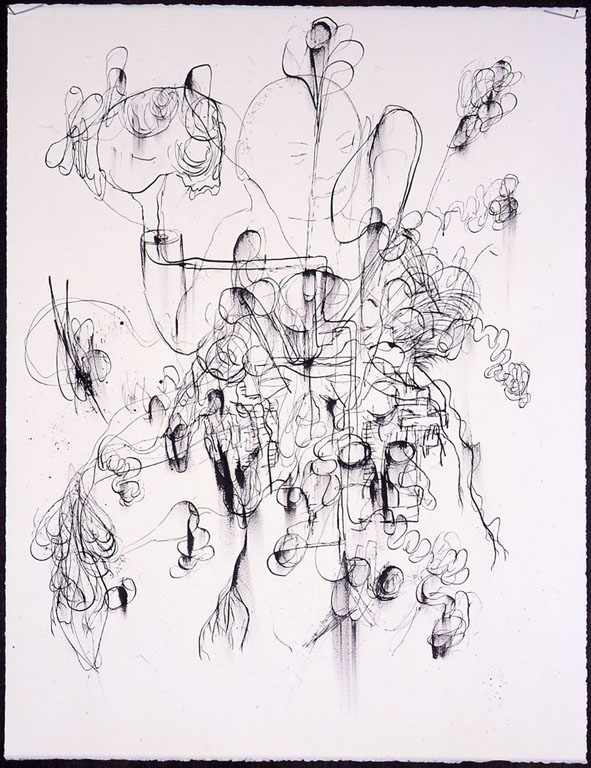We Can Be Heroes: Cameron Jamie
Jeffrey Kalstrom writes on Cameron Jamie's show at the Walker as a clarion call for citizen artists–all those who make, throw off your chains! You have nothing to lose but the remote



Cameron Jamie’s work is not as it first appears. Casual viewers, whether they leave the exhibit pleased or pissed, will miss things. The initial aesthetic or stance one sees is that of ultimate slumming cool. You think “Auuhhh! Another artist obsessed with black-metal Goth culture, its disdain, crudity, and sexy stupidity.” Then it would be easy to dismiss Jamie as another artist milking trash for cash.
Later you realize he is really after something quite different —something infinitely warmer. His investigation of backyard wrestling and homemade haunted houses has a gentle, respectful, even admiring tone—weird as that sounds. Jamie involves himself with these groups and studies them over the course of years. He’s obsessed with activities and artifacts made by youth culture, unwashed and uneducated. He is interested in how these groups translate and recreate culture to suit their own needs. His interest goes beyond ironic amusement, or trying to abolish aesthetic hierarchies. Jamie seems genuinely excited by the ways cultural ceremonies and symbols can be used to create personal mythologies of power.
I’m not saying he’s a social crusader. He’s an artist, obsessed first with investigating those bits of the world that amaze him. He then creates work, which distills and translates this new information. Some reviewers have interpreted his work as social criticism. They speak of his exposing the “failure” of the American suburbs or of American culture. Jamie does speak of his desire to “show middle-class utopia in America as a third–world hell”. But I feel he also exposes worlds of self-creation in which those who have been disposed of take images/tropes/styles of the cultural mainstream and remake them into their own. Embodied in his work is recognition of the power of marginal groups to create zones of freedom through self-creation.
There is a tremendous variety of work in this exhibition, including the range of media: painting drawing, sculpture, installation, video, and found objects. Some of the work is created by Jamie’s own hand, but a substantial portion is images he’s collected and sculpture he has commissioned. It can be confusing until you figure this out as the varied levels of technique are dizzying at first glance. Some work is stunningly crafted (like the “Kranky” masks, carved by a traditional German mask-carver), other objects are rough, even crude. This serves to put you on notice that craft is not a primary goal, but rather shifts with the reasons the objects were made. The various levels of craft keep you guessing, and keep your vision fresh.
What is the center of Jamie’s work? Is he a documentary filmmaker who also creates art objects? Or is he an artist who simply uses film as one of his tools? It was his films that first brought him attention and they remain his signature work. The following videos are shown in the Walker film screening room.
“BB,” soundtrack by The Melvins
This is Cameron Jamie’s signature work. It’s an intensely filmed look at the San Fernando Valley backyard wrestling scene in the late 20th century. Driven by a pumping soundtrack created by the Melvins (Jamie’s band), it is vivid, and visceral, and a little scary. It is part of a trilogy along with the films “Spook House” and “Kranky Klaus”.
“Spook House”
An affectionate document of the preparation for Halloween by teenagers in Detroit making their own homemade haunted houses. The obvious fakeness of these amateur theatrics has an affecting charm. The transformation of Halloween from a minor children’s event into the most popular adult holiday is a very American transformation. The shift has moved on to Europe, where an American-style Halloween is becoming popular.
“Kranky Klaus,” soundtrack by the Melvins
A mad cinema verite look at a traditional Christmas ritual which embodies Christian and pagan versions of celebrating the solstice– long conjoined in Germany, where this film was made. I do wonder if the presence of the camera spurred the “Krankies” (village heavies dressed in pretty terrifying masks who give some people candy and attack others) to pump up the violence? It does seem like they push things beyond the expectations of their audience—some young girls in the video break into tears. I have heard accounts of similar rites occurring in northern Minnesota at least into the early 60’s – perhaps in some small towns the Christmas pranksters still lurch out on a winter night in search of drink.
“JO,” soundtrack by Keiji Haino
For me this is his least effective video. It does have very exciting soundtrack. The sound work created by guitar master Haino is majestic. The video’s juxtaposition of a hokey French Joan of Arc pageant with the French rightwing politico La Pen’s nationalistic program and Nathan’s 4th of July hot dog eating contest is both random and didactic. The connection between the French and American events is conceptual stretch. The Le Pen and Joan of Arc connection is so obvious as to be dull in the extreme You know Nathan’s 4th of July hot dog eating contest will be gross and by golly it is – so what. American freedom and liberty has always spawned excess and vulgarity. Democracy is messy. Jamie’s crude video editing technique does not work in this instance. Film is not drawing. The direct “brut” technique, which works in a drawing, does not translate well to video – it just becomes dull.
The Walker has scheduled a live performance which according to reviews should be a powerful must see event. (Currently this is perhaps delayed as Haino has had problems getting a performance visa – the New York performance was canceled).
“Neotoma Tape”
A painfully kitschy collection of vintage 70’s video.
A delightful amazing compilation of weirdness – what madness happens when the camera is on? What madness ensues when the inept attempt polished professionalism?
The following videos are shown in the gallery exhibit itself.
“Upland BB”
A slightly later version of backyard wrestling shown in color with a “live sound” non-musical soundtrack. There is a pronounced shift in tone when you hear the “live” wrestlers talking. The Melvin’s soundtrack gives the earlier “BB” a faux heroic tone. I like this real, raw and sloppy version.
“The New Life”
Cameron Jamie in his self-portrait mask wrestling a Michael Jackson impersonator. It is everything it could be and more. A simply charmingly mad vision.
“La Baguette”
Cameron Jamie in his self-portrait mask wrestling a Frenchman. Just like “The New Life’ except without its humor.
There is a complex variety of work in the exhibit. The pen and ink drawings are the most personal distillations of his investigations. The exhibits curator and acting Walker director Philippe Vergne says, “ The drawings are in many ways the spine of the exhibition”. . Despite the rough offhand technique, they are light, elegant, and pack a punch. Their content can curl the hair. The layered images of severed heads, bones, goat’s heads, and trailing intestines organize themselves into a centrally focused symmetrical pattern, emblematic, like a heraldic shield.
Curiously, one of the more elegant colored works created by Jamie’s hand is a small oil on paper work entitled “Heraldic”. The title and form of the piece recalls the Joan of Arc imagery from his latest movie ”Jo”. The heraldic form is related to the sign, the tag, the signature, the self-made identity, and a corporate logo. The work, like the drawings, suggests the development of a personal mythic iconography.
Two major works in the exhibit revolve around Jamie’s attempt to come to grips with and/or exorcise his childhood in the San Fernando Valley, a vast suburbia directly north of Los Angeles.. The works are collectively entitled “Maps and Composite Actions 2001-2004.” The larger work is a walk-through installation which may be viewed by one person at a time, traversing the space holding a small electric lantern. The journey up and around a rough narrow path is suitably exciting. When you arrive in the central cavern the drawings and paintings accompanied by texts are too un-theatrical to sustain the mood of the work. After the rigors of the jouney one wants magic, not small print to read.
The other work in this series is a map of the Valley overlaid with scrabbling bits of text and several images – one of which is a crude drawing of Dracula. This is a pseudo document of a series of performances Cameron Jamie performed in various locations in the Valley. For these performances Jamie adopted the identity of Dracula and visited bars and clubs. He did this accompanied by a friend. There was no video or photographic documentation of the performances– briefly described as experiments in provocation. Mr. Cameron acts in an odd provocative manner and occasionally tries to pick fights. Jamie creates personal mythologies of belief with these performances by making you take their existence on faith. You are challenged to question his honesty in a “believe it or not gesture”.
There is an undercurrent in Jamie’s work of an effort to expand the artist’s role beyond that of an object maker. In Jamie’s study, collecting of artifacts, commissioning work to be fabricated, there is an adoration of the amateur. One disease of the modern world is professionalism, a doctrine by which only the ‘best’ should practice their art. The rest of us must be content to watch and buy. This culture of “spectators’ makes us embarrassed by the regional, the homemade, and the non-coastal.
One point I take away from Jamie Cameron’s work is “stop watching and do” – make up your own games, rituals, pranks. Live, don’t watch. There is a call to a do-it-yourself inherent in his work. The rough, sometimes-sloppy facture of his drawings and object embodies this – you can and should do this now.
What you have to admire about this work is the clarity of its desire. There is the joy of the rough lived life suffusing the work. It is easy to get lost in art world concerns or concepts; while Jamie’s primary interest is in peoples’ daily creation of a mythic plot by which to live with action, not passivity. This is likely a more optimistic interpretation than the artist himself would have of his work. But then again, is it a rare artist that understands his or her own work. Their mission is to awake and excite, which Cameron Jamie’s does in spades.